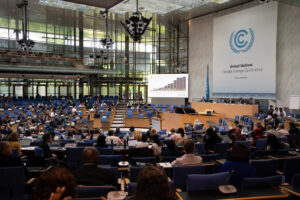The European Commission’s (EC) plan to mobilise more than 1 trillion EUR over the next 10 years to support the EU’s transition to climate neutrality sends a strong signal that the Commission is putting climate action at the centre of its work. It strengthens the case for raising the EU’s 2030 climate target to 65%. The plan must be aligned with other EU climate policies such as the EU Emissions Trading System (EU ETS) and push governments to significantly improve their National Energy and Climate plans (NECPs).

The European Green Deal Investment Plan (EGDIP) is very promising and shows that EC President Ursula von der Leyen is serious about mainstreaming climate finance throughout the EU’s budget.
It is also clearly aimed at convincing laggard member states to get behind the 2050 climate neutrality target. However, access to some of the funding has not been explicitly limited to the countries supporting the 2050 target. This must be corrected so that only countries supporting and planning for climate neutrality have access to the funds. Equally important will be to ensure that investments in fossil fuels are excluded.
The investment plan alone will not be enough to fund the entire climate transition – the EC indicates that 260 billion EUR would be necessary every year up to 2030 to meet the current target of -40% which in itself is not in line with what the atmosphere demands and the Paris Agreement needs. However, it should pave the way to raising the EU’s 2030 climate target to -65% and bring it in line with the Paris Agreement.
The Just Transition Mechanism and the Just Transition Fund
One key component of the EGDIP is the Just Transition Mechanism (JTM) which is aimed at alleviating social and economic impacts of the transition to a climate-neutral EU by 2050.
While the transition will create new jobs and foster the development of some economic sectors (such as electric mobility and renewable energy production), carbon-intensive sectors and those relying on fossil fuels will either need to transform or disappear. The social cost of that transition should not be borne by workers in those sectors. Instead, policy-makers should do everything in their power to ensure those workers also benefit from the climate transition.
The EC promises to mobilise at least 100 billion EUR (over the 2021-2027 period) through three channels under the JTM.
- The Just Transition Fund (JTF) is the only one for which details have been made available. It is to be funded with 7.5 billion EUR of additional Member State contributions to the EU budget (which itself is still under negotiation). Together with mandated national co-financing and contributions from other EU funds, it would reach an overall financing capacity of 30-50 billion EUR.
- A new investment scheme will be created under the auspices of InvestEU – leveraging up to 45 billion EUR.
- The European Investment Bank would mobilise between 25 and 30 billion EUR public finance through a – yet to be set up – public loan facility.
How will the Just Transition Fund work?
All member states will receive a piece of the cake, and much ink has already been spilled about who will get how much. While on the one side there are member states that do not want to pay more into the EU budget, on the other side there are countries clamouring that the JTM is insufficient to fund their climate transition.
The Commission is proposing a very complicated formula to allocate funds. Poland would receive the most (2 billion EUR – the maximum possible) – seen as a way to convince them to endorse the EU’s climate neutrality target. Luxembourg would receive the least (4 million EUR). Surprisingly, Germany would claim the second biggest slice (877 million EUR) – perhaps as a carrot for them to increase their contribution to the EU budget (Germany is already the biggest net-payer)?
Each country will have to submit (one or more) ‘territorial just transition plans’ to explain how the funds will be used and which other contributions will be mobilised for the transition in a specific region. In addition, these plans will need to be in line with national energy and climate plans (NECPs) AND with the EU 2050 climate neutrality target.
The JTF will focus on pushing among others greenhouse gas emission reductions, economic diversification, research and innovation, support for job seekers and up-/reskilling of workers in industrial, power and extractive sectors (including coal mining). The JTF explicitly rules out support for fossil fuel infrastructure, production or consumption.
How could it be improved?
The Just Transition Mechanism and Fund are very good steps in the right direction, as is the overall European Green Deal Investment Plan. However, more details are necessary on how they will work and interact with other EU and national policy tools. For example, the EU Emissions Trading System (EU ETS) and its Market Stability Reserve will need to be strengthened if the JTM succeeds at speeding up coal phase-outs.
The Just Transition Mechanism should push the Member States to raise their domestic ambition and to significantly improve their NECPs.
A major issue is that the ‘territorial just transition plans’ need to be in line with both the NECPs and the climate neutrality target. Currently, the NECPs themselves are not in line with the current unambitious 2030 target, let alone the 2050 climate neutrality target. The Just Transition Mechanism should push the Member States to raise their domestic ambition and to significantly improve their NECPs.
The JTM is currently insufficient to fund all just transition needs across the EU. EU ETS auctioning revenues should be used to help strengthen it and ensure that EU ETS revenues are indeed used to further the EU’s climate transition.
The Commission seems serious about the need to transition the EU economy and society to carbon neutrality and wants to shift the EU budget and private finance towards climate action and sustainable investments. At Carbon Market Watch, we will follow closely how these plans will translate into concrete climate action that will leave no one behind.






